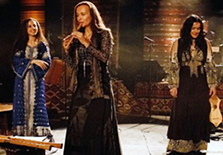 There are three types of Sephardic songs—topical and entertainment songs, romance songs and spiritual or ceremonial songs. Lyrics can be in several languages, including Hebrew for religious songs, and Ladino.
There are three types of Sephardic songs—topical and entertainment songs, romance songs and spiritual or ceremonial songs. Lyrics can be in several languages, including Hebrew for religious songs, and Ladino.
Songs which are song by women are traditionally sung while performing household tasks, without accompaniment or harmony. Tambourines and other percussion instruments are sometimes used, especially in wedding songs. Oud and qanún are also used in some instrumentations of Sephardic music, and more modern performers incorporate countless other imported instruments.
Sephardic music has its roots in the musical traditions of the Jewish communities in medieval Spain. Since then, it has picked up influences from Morocco, Argentina, Turkey, Greece, and the other places that Spanish Jews settled after their expulsion from Spain in 1492. Lyrics were preserved by communities formed by the Jews expelled from the Iberian Peninsula. These Sephardic communities share many of the same lyrics and poems, but the music itself varies considerably.
Because so many centuries have passed since the exodus, a lot of the original music has been lost. Instead, Sephardic music has adopted the melodies and rhythms of the various countries where the Sephardim settled in. The Greek and Turkish traditions are fairly close. The Moroccan or “western” Sephardic traditions are not that close to the eastern/Greek/Turkish traditions.
“Morena” (partial translation): They call me Morena – dark-skinned, dark-eyed and dark-haired girl, I used to be white first, but the sun made me dark. Morena! he calls me, the son of the King, and if he calls me that once again, I will run away with him. Morena! they call me, the seamen, and if they call me so once again, I will run away with them.